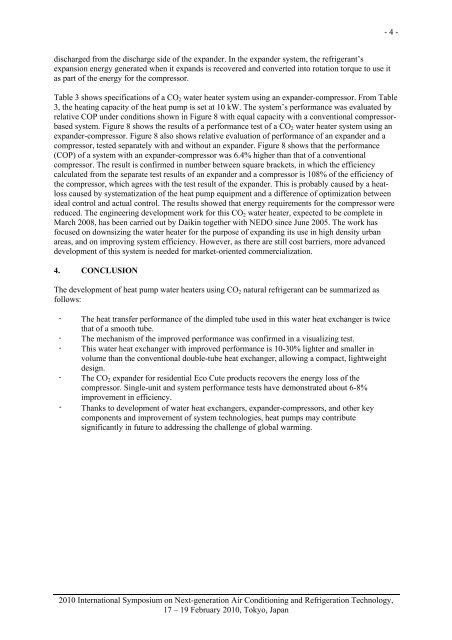The Development of Heat Pump Water Heaters Using CO2 Refrigerant
The Development of Heat Pump Water Heaters Using CO2 Refrigerant
The Development of Heat Pump Water Heaters Using CO2 Refrigerant
Create successful ePaper yourself
Turn your PDF publications into a flip-book with our unique Google optimized e-Paper software.
- 4 -<br />
discharged from the discharge side <strong>of</strong> the expander. In the expander system, the refrigerant’s<br />
expansion energy generated when it expands is recovered and converted into rotation torque to use it<br />
as part <strong>of</strong> the energy for the compressor.<br />
Table 3 shows specifications <strong>of</strong> a CO 2 water heater system using an expander-compressor. From Table<br />
3, the heating capacity <strong>of</strong> the heat pump is set at 10 kW. <strong>The</strong> system’s performance was evaluated by<br />
relative COP under conditions shown in Figure 8 with equal capacity with a conventional compressorbased<br />
system. Figure 8 shows the results <strong>of</strong> a performance test <strong>of</strong> a CO 2 water heater system using an<br />
expander-compressor. Figure 8 also shows relative evaluation <strong>of</strong> performance <strong>of</strong> an expander and a<br />
compressor, tested separately with and without an expander. Figure 8 shows that the performance<br />
(COP) <strong>of</strong> a system with an expander-compressor was 6.4% higher than that <strong>of</strong> a conventional<br />
compressor. <strong>The</strong> result is confirmed in number between square brackets, in which the efficiency<br />
calculated from the separate test results <strong>of</strong> an expander and a compressor is 108% <strong>of</strong> the efficiency <strong>of</strong><br />
the compressor, which agrees with the test result <strong>of</strong> the expander. This is probably caused by a heatloss<br />
caused by systematization <strong>of</strong> the heat pump equipment and a difference <strong>of</strong> optimization between<br />
ideal control and actual control. <strong>The</strong> results showed that energy requirements for the compressor were<br />
reduced. <strong>The</strong> engineering development work for this CO 2 water heater, expected to be complete in<br />
March 2008, has been carried out by Daikin together with NEDO since June 2005. <strong>The</strong> work has<br />
focused on downsizing the water heater for the purpose <strong>of</strong> expanding its use in high density urban<br />
areas, and on improving system efficiency. However, as there are still cost barriers, more advanced<br />
development <strong>of</strong> this system is needed for market-oriented commercialization.<br />
4. CONCLUSION<br />
<strong>The</strong> development <strong>of</strong> heat pump water heaters using CO 2 natural refrigerant can be summarized as<br />
follows:<br />
- <strong>The</strong> heat transfer performance <strong>of</strong> the dimpled tube used in this water heat exchanger is twice<br />
that <strong>of</strong> a smooth tube.<br />
- <strong>The</strong> mechanism <strong>of</strong> the improved performance was confirmed in a visualizing test.<br />
- This water heat exchanger with improved performance is 10-30% lighter and smaller in<br />
volume than the conventional double-tube heat exchanger, allowing a compact, lightweight<br />
design.<br />
- <strong>The</strong> CO 2 expander for residential Eco Cute products recovers the energy loss <strong>of</strong> the<br />
compressor. Single-unit and system performance tests have demonstrated about 6-8%<br />
improvement in efficiency.<br />
- Thanks to development <strong>of</strong> water heat exchangers, expander-compressors, and other key<br />
components and improvement <strong>of</strong> system technologies, heat pumps may contribute<br />
significantly in future to addressing the challenge <strong>of</strong> global warming.<br />
2010 International Symposium on Next-generation Air Conditioning and Refrigeration Technology,<br />
17 – 19 February 2010, Tokyo, Japan
















